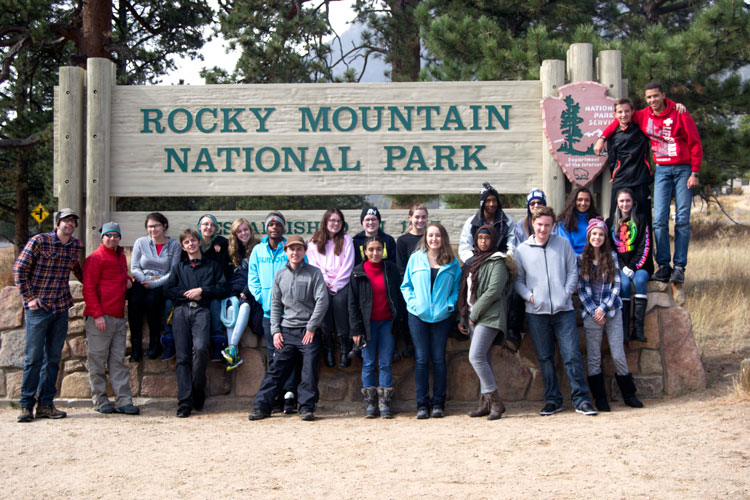
Students enjoyed the opportunity to get out of the classroom and visit Rocky Mountain National Park to learn about the environment. photo courtesy of Brett Butera
A unique AP Environmental field trip introduces the outdoors into the classroom, fulfilling the wonders of education.
On October 6th, 2016, science teacher Brett Butera brought his AP Environmental Science Class on a day trip to Rocky Mountain National Park. His goal was to enhance student’s knowledge of climate change, biodiversity, and species migration, and how they are impacting the park’s ecosystems. Originally, it was in the park’s hopes that students would collect data to track tree species migration in order to gain an understanding of how trees are moving across the landscape and changing the ecosystems. However, the weather did not permit this. Instead, students met with Scott Esser, an ecologist working for the Continental Divide Research Learning Center, who strives to engage youth in environmental studies through education, internships, and Citizen Science. Citizen Science is a term to describe the general public collaborating with scientists in order to collect and analyze data relating to the natural world. The students who went on the trip partook in the Citizen Science program that was set up by Butera who had been planning this for roughly a year, and Esser, who leads the programs. The trip was paid for by TJ Partners PTO, principal Mike Christoff, and the TJ Poinsettia Fund, a fundraiser held each winter to raise money for the science department. Even though the trip didn’t go as planned due to the weather, students were still immersed in information about the mountain ecosystem that would aid their studies in the classroom.
The Citizen Science Program allows students to be thoroughly educated on biodiversity and its importance. “By understanding how ecosystems change over time we can better preserve them for the future. Also, by understanding how specific species respond to change over time, we can understand which species may be most healthy and suited for the future,” explained Esser.
When Butera began teaching at TJ almost eleven years ago, he envisioned providing a variety of experiential hands-on environmental learning opportunities for his students. When he began teaching AP environmental science almost four years ago, his vision began to come to fruition. With his current project, his goal was to give his students an authentic encounter with nature, as well as the opportunity to conduct authentic scientific research and collect data for the park service. Butera worked in Estes Park for five different seasons doing a variety of jobs. Having a strong connection towards the park, it was easy to choose Rocky Mountain National Park from all the other possible field sites. If the trip had gone as planned, the data wouldn’t have had an instant effect on the park, but rather it would have been the baseline from which future classes could see a change over time. Butera stated, “It would have contributed to a larger body of scientific data that the park could then use to decide things like where they could implement facilitated migration. “So, if I go to a different plot every year with my students and see one plot seems to be adapting really well or if we see another plot that’s not adapting as well, park scientists can make decisions on which plots they would put their emphasis on. These would be known as areas of refugia.”
Rocky Mountain National Park is an incredibly diverse place that houses an abundance of species found only above treeline, and encloses one of the vastest areas of alpine tundra in the southern Rockies. The diverse mountain topography also allows for a very widespread genre of habitats, accommodating a plethora of species, all of which migrate in one way or another. Tree species migration is an essential concept in allowing species to move because it dictates future landscapes, ultimately creating a diversified ecosystem. However, if these trees are not able to be preserved correctly, they will begin to lack habitat diversity. Esser compared data tree species data collected in 1973 with data collected in 2013 to determine what change has taken place over the past 40 years. Students then thoughtfully examined these data to see how the data can show environmental impacts to an ecosystem. He found a decline in small diameter trees, an increased density of larger diameter trees, and the migration of multiple species, both upslope and downslope, all of which could be a response to climate change. Nonetheless, not all trees are adapting at the same rate.
By comparing data collected from north-facing and south-facing slopes, the park learned that northern slopes have yet to react to the change in climate in the same way that the southern slopes have. Students had the opportunity to see and learn about this in the field looking at actual trees. Furthermore, students got to learn about aspen enclosures, what they protect and how effective they have been to preserving species. In Estes Park, there has been a decline of aspen trees over the years due to overpopulated elk, which then required an enclosure to protect the vegetation for it to regenerate. Junior Tyler Moffat said, “I learned how as a society we can kill our ecosystem, but there’s also people that are working 24/7 to make sure that it thrives.”
By going on the trip, students and teachers alike were positively affected by the outcomes that were produced. Students gained a better understanding of biomes and what their importance to the Earth is outside of the classroom and were exposed to their studies in real life. Butera’s thoughtful planning and preparation made it possible for many students to expand their horizons in the field of science.